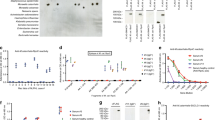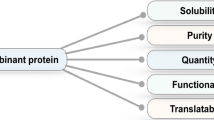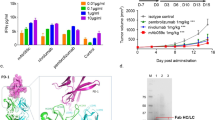Abstract
We have successfully established one murine hybridoma that secretes a monoclonal antibody specific for the 77,000 subunit of human DNA polymerase alpha. The results of immunochemical studies, using HDR-854-E4 monoclonal antibody (MAb) and immunoperoxidase detection methods, demonstrate intranuclear and intracytoplasmic localisation of the subunit in all the human culture cell lines tested. The immunoperoxidase reaction product exhibits a diffuse pattern of distribution within the cytoplasm and nucleoplasm, but nucleoli are clearly negative. In cultured cell lines, HeLa and KATO III, more than 95% of the cells are positive, suggesting that the subunit antigens persist throughout the mitotic cycle. No subunit antigen was recognised in resting mononuclear cells (MNC). Immuno-electron microscopic examination of HeLa cells confirms and extends these observations. We have further examined the expression level of the subunit antigen in various normal and cancerous tissues. Strong reaction was observed in proliferating normal and cancer cells such as cancer cells from the gastrointestinal (GI) tract, thyroid, malignant lymphoma, breast, cells in the germinal centres of lymph nodes, epithelial cells in the GI tract and nephrogenic zones in fetal kidney. Finally, we utilised this antibody as a diagnostic tool in biopsies of the thyroid and GI tract. Thyroid cancer was stained positively with this antibody, while follicular adenoma was not. Gastric cancer was stained strongly and adenomatous polyp and hyperplastic polyp were stained moderately. This antibody is not only specific and powerful for application of a novel approach to the complex biochemical mechanisms of mammalian DNA replication, but also useful for distinction between proliferative and non-proliferative lesions.
This is a preview of subscription content, access via your institution
Access options
Subscribe to this journal
Receive 24 print issues and online access
$259.00 per year
only $10.79 per issue
Buy this article
- Purchase on Springer Link
- Instant access to full article PDF
Prices may be subject to local taxes which are calculated during checkout
Similar content being viewed by others
Author information
Authors and Affiliations
Rights and permissions
About this article
Cite this article
Sugawara, I., Uchino, K., Morishita, Y. et al. Intracellular localisation of a subunit of human DNA polymerase α affecting primase activity recognised by monoclonal antibody (HDR-854-E4) and its application to distinction between proliferative and non-proliferative lesions. Br J Cancer 60, 176–181 (1989). https://doi.org/10.1038/bjc.1989.246
Issue Date:
DOI: https://doi.org/10.1038/bjc.1989.246



